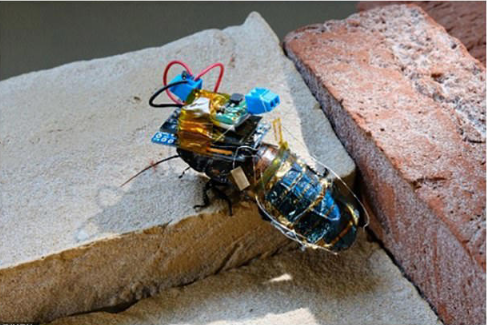科学家们以马达加斯加蟑螂为灵感,制造出一款新型遥控蟑螂机器人。这种机器人是蟑螂和机器人的混合体,无需充电,可进入危险区域进行环境监测或执行搜救援任务。

While it may sound like something that has crawled out of your nightmares, cyborg cockroaches have arrived as friends rather than foes.
虽然蟑螂机器人听起来很恐怖,但是它其实是人类的朋友而非敌人。
Scientists in Japan have designed a new remote-controlled insect, equipped with a battery 'backpack' that is powered by solar panels.
日本科学家设计了一款新型遥控蟑螂机器人,它配备了由太阳能电池板供电的电池“背包”。
The cockroach, which is part insect and part machine, is intended to enter hazardous areas, monitor the environment or undertake search and rescue missions without needing to be recharged.
这种蟑螂机器人是蟑螂和机器人的混合体,无需充电,用于进入危险区域,监测环境或执行搜救援任务。
The researchers from the RIKEN Cluster for Pioneering Research had to install some components into a tiny pack to allow for all the roach's natural movements.
来自RIKEN Cluster的研究人员进行了开创性的研究,他们必须将一些组件安装到一个小背包中,以便让蟑螂自由行动。
Lead author Kenjiro Fukuda said: 'The body-mounted ultrathin organic solar cell module achieves a power output of 17.2 mW, which is more than 50 times larger than the power output of current state-of-the art energy harvesting devices on living insects.'
研究报告的主要作者福田健次郎称:“安装在蟑螂机器人身体上的超薄有机太阳能电池模块的输出功率为17.2兆瓦,比目前最先进的昆虫能量收集装置的输出功率高出50多倍。”
Famously able to survive a nuclear war, cockroaches have been the inspiration for a number of technologies in recent years.
众所周知,蟑螂能够在核战争中幸存下来,近年来,它一直是许多技术的灵感来源。
Different teams of scientists have designed remote-controlled robo-bugs that can scale walls, carry objects and find humans during search-and-rescue missions.
一些科学家团队设计了可遥控的昆虫机器人,它们可以在搜救援任务中穿墙、携带物体和寻找人类。
The cockroaches are still alive, but wires attached to their two 'cerci' - sensory organs on the end of their abdomens - send electrical impulses that cause the insect to move right or left.
蟑螂机器人是有生命的,但连接在蟑螂腹部末端的两个感觉器官“尾蚴”上的电线发出电脉冲,控制它左右移动。
A battery is necessary for the sending and receiving of these electrical signals, which needs to be charged up.
发送和接收这些电流信号需要电池,而电池需要充电。
While it's possible to build docking stations for recharging the battery, the need to return and recharge could disrupt time-sensitive missions.
虽然可以建造充电站为电池充电,但返回充电可能会使时间紧迫的任务中断。
The RIKEN team wanted to create a more practical version that did not need to return to a docking station when it ran out of power.
RIKEN团队希望打造一个更实用的蟑螂机器人,在电源耗尽时不需要返回充电站。
Therefore, they designed an on-board solar cell that could continuously ensure that the cockroach stays charged while it works.
因此,他们设计了一种太阳能电池,可以持续确保蟑螂在工作时保持充电。
However, cockroaches have a limited surface area available for all the components necessary to move its legs and keep it powered.
然而,蟑螂的大小限制了它可以携带的腿部遥控组件的大小。
The solution, published in npj Flexible Electronics, was to design a special 'backpack' that could neatly carry both the wireless leg-control module and rechargeable lithium polymer battery.
于是研究人员设计了一种特殊的背包,以便于蟑螂携带遥控模块和可充电锂聚合物电池。这一研究成果发表在《npj-柔性电子》上。
This was attached to the top of the insect on its thorax, and was 3D printed to fit perfectly to the curved surface of the Madagascar cockroach or Gromphadorhina portentosa.
研究人员将背包固定在蟑螂的胸腹上部,并运用3D打印技术使其完美贴合马达加斯加蟑螂的身体。
It allowed for this electronic device to be stably mounted on the insect for over a month, while leaving space elsewhere on the body to implant the solar panel.
这种电子设备可以固定在蟑螂身上一个多月,同时还留出空间给蟑螂植入太阳能电池板。
The 0.004 mm thick organic solar cell module was mounted on the dorsal side of the roach's abdomen.
0.004毫米厚的有机太阳能电池模块安装在蟑螂腹部的背侧。







